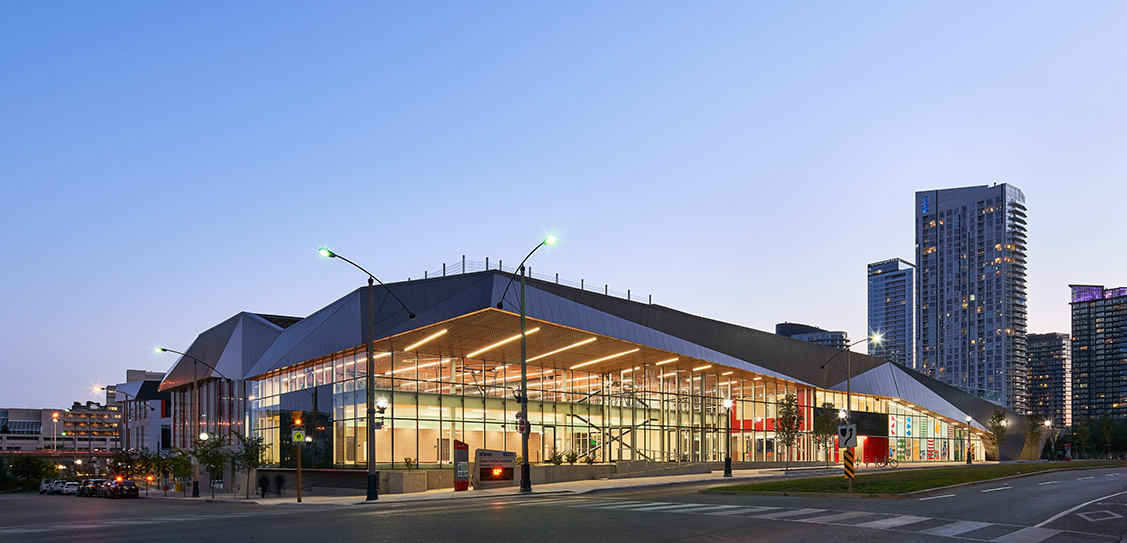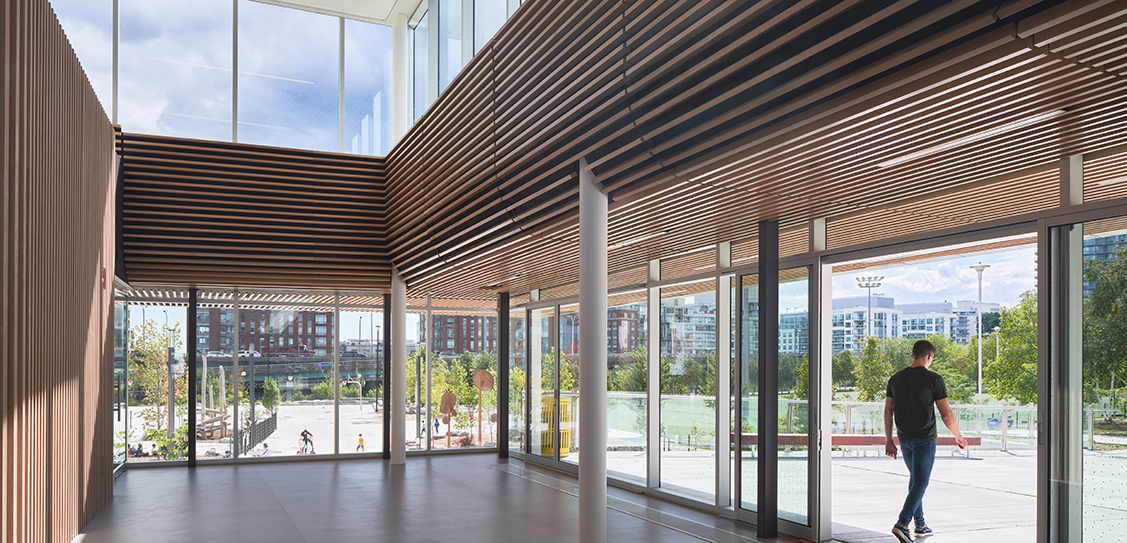The brief was to provide CityPlace, one of Toronto’s most populated residential developments, with the social infrastructure it needed. Extensive planning and design options were explored to ensure that the new facility merged into the existing and widely popular Canoe Landing Park. The result is a layered site with multiple public zones and play areas.
The new campus provides opportunity for shared community spaces and programming offers expanded possibilities for all ages. The schools share indoor play spaces, a learning commons, gymnasium and educational areas. The outdoor park and community rooms are accessible by all. Bisected by a pedestrian corridor, the two storey community centre connects with the three storey schools through an elevated bridge, forming an east-west gateway.
Visible from the residences above, the dynamic roof is a vital element, both from a programming and sustainability perspective. Programming includes a running track, sheltered outdoor space for yoga and a full-sized basketball court. Neighbours in the adjacent residential towers now enjoy the views, similar to that of an open-air stadium.
Embedded within the outer frame, the “active roof” is complemented with passive zones, such as allotment gardens that serve the general neighbourhood and dense vegetation to control and improve water quality. Sustainability and resiliency are prominently integrated, including the introduction of photovoltaic panels to generate 10% renewable energy to meet the highest level of the city of Toronto Green Standards.
Both schools and the city’s childcare centre have separate and distinct street entrances. This three storey area of the building is organisationally stacked with the younger students on the lower level and the older grades on the upper two levels. A central motor skills area for kindergarten students transitions vertically through the building to become a learning commons area for older students. Common areas are integrated and shared including the two gymnasiums, learning commons and playgrounds.
ZAS Architects also partnered with the Ontario Science Centre (OSC) to build its first-ever imagination-based indoor play and community space. The active space fosters learning around themes of urban food production, construction, the natural environment, and scientific principles. Learning apparatuses inspire imagination and creativity, ranging from an operational tower crane to a roller coaster track, climbing wall, oversized building blocks, and communication system with video projectors.
The outdoor space for the Canoe Landing Campus was designed to provide much-needed relief and connection to nature in an intensely urban environment. Native flora and natural elements were utilised to reconnect the site to its biospheric location. The intersection of pedestrian thoroughfares is marked by a “Listening Ears” public art installation and low benches shaded by trees, that provide a passive opportunity for people to watch or catch up with neighbours. During the school day, the site is a protected learning landscape of open-ended naturalised play and didactic elements including an outdoor classroom, climbing structures, and basketball courts. After hours, the site is opened to the community, transforming into an impromptu amphitheatre, basketball courts, and pedestrian routes that become promenades on which to see and be seen.
Along the streetscape, a transparent façade ultimately leads to a large, multi-purpose community room, conceived to host large events from farmers’ markets to cultural presentations. The cultural ambition of this space was further galvanised by a creative partnership with The Bentway Conservancy, an independent charity that operates, maintains, and programmes under Toronto’s Gardiner Expressway.
Honouring the significance of the site, Canoe Landing Campus integrates Indigenous art as part of its architecture. Anishinaabe artist Que Rock and artist Alexander Bacon were commissioned to create a 90 m long mural on the south wall of the Jean Lamb Public and Bishop MacDonnell Catholic schools as a visual acknowledgement and reminder of Indigenous culture and history of the land. Featuring symbols such as the medicine wheel and the symbolic wisdom of all creatures, and much more, the artwork is funded as part of the City’s StreetARToronto (StART) Partnership Program.



